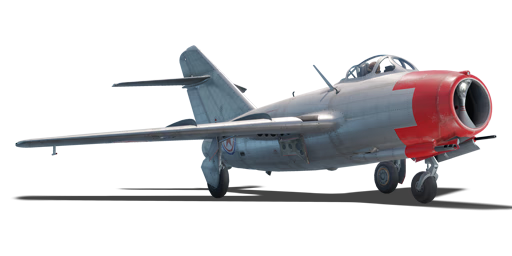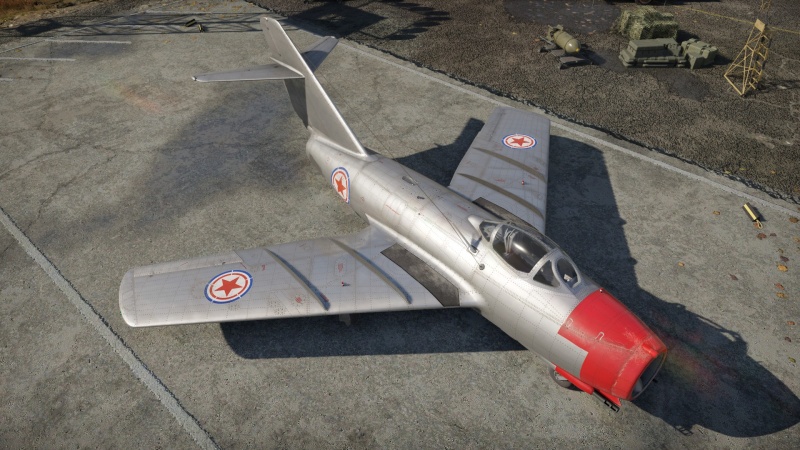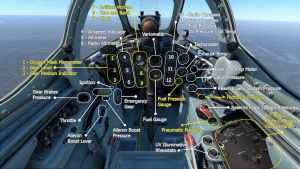Difference between revisions of "MiG-15"
m (→Details) |
m (→Details) |
||
| Line 61: | Line 61: | ||
! Combat !! Take-off !! Landing !! + !! - | ! Combat !! Take-off !! Landing !! + !! - | ||
|- | |- | ||
| − | | {{Specs|destruction|body}} || {{Specs|destruction|gear}} || N/A || 598 || 450 || ~12 || ~ | + | | {{Specs|destruction|body}} || {{Specs|destruction|gear}} || N/A || 598 || 450 || ~12 || ~5 |
|- | |- | ||
|} | |} | ||
Revision as of 18:04, 17 February 2021
| This page is about the Russian jet fighter MiG-15. For other uses, see MiG-15 (Family). |
Contents
Description
The MiG-15 is a rank V Soviet jet fighter with a battle rating of 8.7 (AB), 8.0 (RB), and 8.3 (SB). It was introduced in Update 1.35. The main differences between this aircraft and the MiG-15bis are weaker engine performance and NR-23 23 mm autocannons.
General info
Flight performance
The MiG-15 has excellent acceleration, climb rate, and energy retention. However, this comes at the cost of extremely high compression at subsonic speeds and a near nonexistent roll rate, as well as underwhelming turn at high speeds.
| Characteristics | Max Speed (km/h at 0 m - sea level) |
Max altitude (metres) |
Turn time (seconds) |
Rate of climb (metres/second) |
Take-off run (metres) | |||
|---|---|---|---|---|---|---|---|---|
| AB | RB | AB | RB | AB | RB | |||
| Stock | 1,009 | 975 | 15500 | 22.4 | 23.7 | 34.2 | 32.5 | 600 |
| Upgraded | 1,067 | 1,050 | 22.8 | 22.1 | 50.8 | 42.0 | ||
Details
| Features | |||||
|---|---|---|---|---|---|
| Combat flaps | Take-off flaps | Landing flaps | Air brakes | Arrestor gear | Drogue chute |
| X | ✓ | ✓ | ✓ | X | X |
| Limits | ||||||
|---|---|---|---|---|---|---|
| Wings (km/h) | Gear (km/h) | Flaps (km/h) | Max Static G | |||
| Combat | Take-off | Landing | + | - | ||
| 0 | 450 | N/A | 598 | 450 | ~12 | ~5 |
| Optimal velocities (km/h) | |||
|---|---|---|---|
| Ailerons | Rudder | Elevators | Radiator |
| < 600 | < 700 | < 750 | N/A |
Engine performance
| Engine | Aircraft mass | ||||||
|---|---|---|---|---|---|---|---|
| Engine name | Number | Empty mass | Wing loading (full fuel) | ||||
| Klimov RD-45F | 1 | 3,508 kg | 229 kg/m2 | ||||
| Engine characteristics | Mass with fuel (no weapons load) | Max Takeoff Weight | |||||
| Weight (each) | Type | 10m fuel | 20m fuel | 30m fuel | 33m fuel | ||
| 872 kg | Centrifugal-flow turbojet | 3,875 kg | 4,241 kg | 4,608 kg | 4,718 kg | 5,485 kg | |
| Maximum engine thrust @ 0 m (RB / SB) | Thrust to weight ratio @ 0 m (100%) | ||||||
| Condition | 100% | WEP | 10m fuel | 20m fuel | 30m fuel | 33m fuel | MTOW |
| Stationary | 2,086 kgf | N/A | 0.54 | 0.49 | 0.45 | 0.44 | 0.38 |
| Optimal | 2,086 kgf (0 km/h) |
N/A | 0.54 | 0.49 | 0.45 | 0.44 | 0.38 |
Survivability and armour
- 64 mm Bulletproof glass in the cockpit front
- 10 mm Steel plate in front of the pilot in the nose
- 6 mm Steel plate in pilot's seat
- 10 mm Steel plate behind the pilot's head
Modifications and economy
Armaments
Offensive armament
The MiG-15 is armed with:
- 1 x 37 mm N-37D cannon, nose-mounted (40 rpg)
- 2 x 23 mm NS-23 cannons, nose-mounted (80 rpg = 160 total)
Both the N-37D and the NS-23 cannons have the muzzle velocity of 690 m/s.
Suspended armament
The MiG-15 can be outfitted with the following ordnance:
- Without load
- 2 x 100 kg FAB-100M-43 bombs (200 kg total)
- 2 x 250 kg FAB-250M-46 bombs (500 kg total)
Usage in battles
At higher ranks of the Soviet aviation line, the MiG-15 series is one of the most iconic jet fighter aircraft designs from after the Second World War. Earning its reputation on fame over the skies of Korea against its US contemporary, the F-86 Sabre.
The MiG-15 can be researched from its predecessor, the MiG-9/L. The MiG-15 features a powerful cannon arrangement of 2 x 23 mm and 1x 37 mm, excellent high altitude performance and is highly effective in vertical manoeuvres. Unlike the MiG-9, the MiG-15 is also the first Soviet jet aircraft to feature an air brake which is extremely useful in combat situations. The jet fighter does, however, have its downsides. The lack of an "All-flying tailplane" (such as that featured on the Sabre) leads to less control over the aircraft at higher speeds approaching 1,000 kph. While the MiG is initially faster in acceleration by comparison to the Sabre, this does mean that once both aircraft are up at higher speeds, the Sabre will hold some advantages over the MiG-15. It should be noted that if you load 8 minutes of fuel instead of the regular (for most pilots) 20, it drastically improves your performance. However, this is not recommended to be done at the beginning of the match as most matches last longer than 8 minutes, and should instead be done when you land mid-match.
The combination of 37 mm and 23 mm cannons creates aiming issues for pilots not familiar with their ballistic properties or velocity. Due to the size of these cannons, ammunition pools are restricted by comparison to other top tier jet aircraft. To help compensate the two different trajectories of the armament, it is recommended to use 'rolling' manoeuvres, as the rudder may lock in high speeds. To aim with these cannons, it is best to estimate the lead with the experience built up with planes beforehand (ie.: Yak-9T / La-9) and add extra distance over the estimated lead (about double from the estimated).
Once pilots have learned to use the MiG-15s excellent rate of climb, acceleration and high altitude capabilities to their advantage, the downsides of the aircraft are far less significant than the positives. In the right hands, the MiG-15 can be a devastating combatant, capable of dealing with any aircraft in game swiftly. Teamwork, Squads and communication will also be beneficial when flying the MiG-15 as effective coordination between multiple pilots allow you to use this aircraft to its maximum potential. After mastering the MiG-15, you can research its improved variant, the MiG-15Bis. As the MiG-15 is essentially a slightly merged MiG-15bis, it shares much of its performance issues and abilities.
Pros and cons
Pros:
- Flaps can be deployed at high speeds
- Capable and useful air brake
- High rate of climb
- Great acceleration
- Deadly armament capable of making snapshots
- Excellent energy retention
Cons:
- Abysmal roll rate
- Poor turning circle
- Compression at high speeds
- Extremely challenging to use when stock
- Armament difficult to use (low velocities, low ammo and two different trajectories)
- Guns tend to spark a lot (the N-37 in particular)
- No G-suit, so maintaining control is difficult when turning at high speeds
- No S-21 rockets
- Poor forward visibility in simulator, as a large canopy frame and the gunsight block the top and bottom
History
First taking to the air in December of 1947, the Mikoyan-Gurevich MiG-15 jet fighter aircraft came as a massive shock to the west when it appeared in the skies over Korea in the early 1950s. The swept-wing fighter quickly proved itself as a capable and effective combat aircraft and forged a fearsome reputation.
The prototype I-310 was designed around the British Rolls Royce Nene engine which was purchased under license from Great Britain as the RD-45. Featuring sleek swept-back wings, tricycle undercarriage and the same armament as its predecessor, the MiG-9, in the form of 2 x 23mm NS-23 cannons (Later replaced by NR-23 cannons in the MiG-15Bis model) and a single 37mm N-37D cannon all mounted centrally under the nose intake. The new aircraft was designed as an interceptor with heavy armament capable of quickly taking out bomber formations and was one of the most advanced aircraft in the world at the time.
Entering service between 1949-50, the MiG-15 made its operational combat debut in the Korean War, completely outclassing the first-generation jet fighter aircraft of the UN forces such as the F-80 and F-84. The MiG's excellent rate of climb, high-speed performance and deadly weaponry proved superior to the early jets and was only challenged by the arrival of the North American F-86 Sabre. At the time, the Sabre was the only aircraft capable of effectively combating the MiG in aerial combat and the pair became synonymous with the conflict.
From 1950, the MiG-15 was later developed into the Bis model, featuring a new engine, armament changes and minor overall improvements. However, the aircraft would ultimately lead to the development of the MiG-17. The MiG-15 was also a hugely successful export aircraft, operated by many nations such as Poland, Czechoslovakia, East Germany, China, North Korea and Vietnam to name but a few. Licence built versions of the MiG-15 also existed such as the Chinese J-2, Czech S-102/3 and Polish Lim-1.
The MiG-15 is a true icon of aviation and will provide experienced pilots with an impressive top tier jet fighter when employed to its strengths, being more than a match to any other aircraft in the game.
In-game description
After World War II was over, the leaders of the USSR realized that they were behind the leading states of the world in the sphere of jet aircraft construction, most notably in the full-scale production of turbojet engines. Consequently, a delegation including the designers A. I. Mikoyan and V. Y. Klimov was sent to Great Britain towards the end of 1946. Their negotiations were successful, resulting in the purchase of two of the most advanced turbojet engines at that time: the Rolls-Royce Derwent Mk.V and the Rolls-Royce Nene I/Nene II. The British consented to sell their newest strategic designs easily enough, since they believed that the Soviet industrial/technological apparatus could not handle the mass production of sophisticated assemblies. However, very soon that the Rolls-Royce engines were launched into full-scale Soviet production under the designations RD-500 and RD-45.
The emergence of the new engines led to the creation of Soviet jet fighters able to compete with the leading models of the world. In 1947, the Mikoyan Design Bureau started the development of a front line fighter with a Nene (RD-45) turbojet engine and an airtight cockpit: the I-310 ("S"). The first S-01 prototype aircraft made its first flight on December 30, 1947, and, after working on the test results, was launched into full-scale production in 1948 under the designation MiG-15. The plane's airframe was an all-metal monoplane configuration with mid-swept wings and empennage. Thus the MiG-15 became the first production swept-wing fighter.
The MiG-15 was equipped with a RD-45F single-shaft turbojet engine rated at 2,270 kg of thrust with a double-entry centrifugal compressor. The plane's armament included a 37mm Nudelman N-37D cannon with 40 rounds and two 23mm Nudelman-Suranov NS-23KM guns with 160 rounds in total. The cannons were mounted in the forward fuselage on a lowerable carriage. Two 100-kg or 50-kg bombs could be suspended under the wings. To increase its flight range, the aircraft could carry two external fuel tanks with a capacity ranging from 250 to 600 liters.
The MiG-15 fighter was notable for its simple and reliable structure, high flight and operating characteristics, and powerful armament. Its maximum speed, rate of climb, ceiling, and flight range were the best among Soviet fighters at the time and superior to many foreign aircraft, as well.
The first production MiG-15s with RD-45F engines began to leave the factory floor in early 1949. In 1950, more advanced MiG-15bis fighters replaced them in the factory assembly lines.
Media
Excellent additions to the article would be video guides, screenshots from the game, and photos.
See also
Links to the articles on the War Thunder Wiki that you think will be useful for the reader, for example:
- reference to the series of the aircraft;
- links to approximate analogues of other nations and research trees.
External links
| Mikoyan-Gurevich Design Bureau (Микоя́н и Гуре́вич Опытное конструкторское бюро) | |
|---|---|
| Fighters | MiG-3-15 · MiG-3-15 (BK) · MiG-3-34 |
| I-225 | |
| Jet fighters | MiG-9 · MiG-9 (l) |
| MiG-15 · MiG-15bis · MiG-15bis ISh | |
| MiG-17 | |
| MiG-19PT | |
| MiG-21F-13 · MiG-21PFM · MiG-21S (R-13-300) · MiG-21SMT · MiG-21bis | |
| MiG-23M · MiG-23ML · MiG-23MLD | |
| MiG-27M · MiG-27K | |
| MiG-29 · MiG-29SMT | |
| Export/Licensed | ␗MiG-9 · ␗MiG-9 (l) |
| ◊MiG-15bis · ◔MiG-15bis · J-2* | |
| MiG-17AS · ◔MiG-17PF · J-4* · Shenyang F-5* | |
| ◊MiG-19S · J-6A* | |
| ◄MiG-21 SPS-K · ◊MiG-21MF · ◔MiG-21MF · ▄MiG-21bis · ◔MiG-21bis-SAU · ◊MiG-21bis-SAU · ◊MiG-21 "Lazur-M" · ▄MiG-21 Bison · J-7II** | |
| ◊MiG-23BN · ◊MiG-23MF · ◔MiG-23MF · ◊MiG-23MLA | |
| ◔MiG-29 · ◊MiG-29 · ◄MiG-29G | |
| *Licensed and domesticated with Chinese designations. | |
| **Unlicensed, reverse-engineered and domesticated with Chinese designations. | |
| See Also | Shenyang · Chengdu |
| USSR jet aircraft | |
|---|---|
| Bereznyak-Isayev | BI |
| Yakovlev | Yak-15 · Yak-15P · Yak-17 · Yak-23 · Yak-28B · Yak-30D · Yak-38 · Yak-38M · Yak-141 |
| Mikoyan-Gurevich | MiG-9 · MiG-9 (l) · MiG-15 · MiG-15bis · MiG-15bis ISh · MiG-17 · MiG-17AS · MiG-19PT |
| MiG-21F-13 · MiG-21PFM · MiG-21S (R-13-300) · MiG-21SMT · MiG-21bis | |
| MiG-23M · MiG-23ML · MiG-23MLD · MiG-27M · MiG-27K | |
| MiG-29 · MiG-29SMT | |
| Lavochkin | La-174 · La-15 · La-200 |
| Sukhoi | Su-9 · Su-11 |
| Su-7B · Su-7BKL · Su-7BMK · Su-17M2 · Su-17M4 · Su-22M3 | |
| Su-24M | |
| Su-25 · Su-25BM · Su-25K · Su-25T · Su-25SM3 · Su-39 | |
| Su-27 · Su-27SM | |
| Su-34 | |
| Ilyushin | IL-28 · IL-28Sh |
| Tupolev | Tu-14T |






